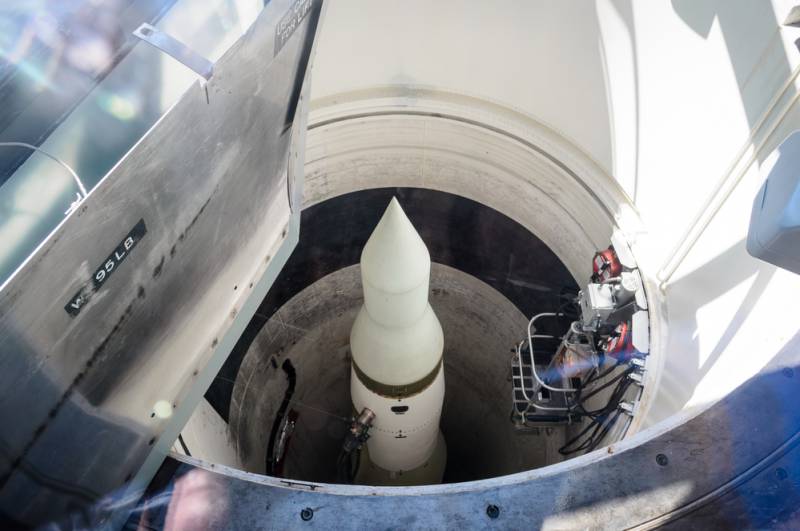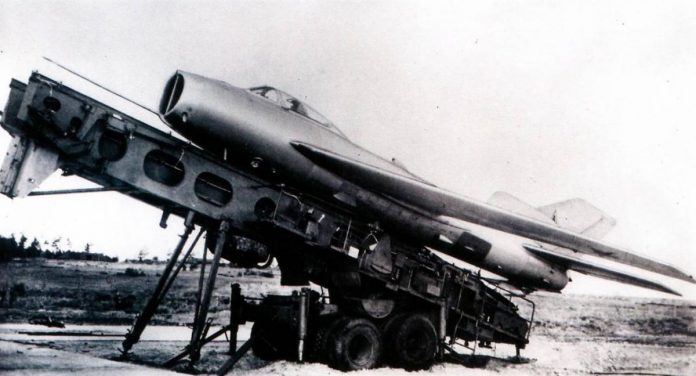 MIG-19 (SM-30)
MIG-19 (SM-30)
Even in Soviet times, many travelers surprised unexpected improvement in the previously "dead" of roads and increase their width. Luxury road could appear almost deserted steppe and suddenly disappear in just a few kilometers. The solution to this riddle was simple: individual sections of roads were created to satisfy needs of military. In the case of a full-scale military conflict, which would result in strikes on airfields, Motorway could replace them. Special engineering and airfield services can deploy a spare mobile airfield in the most unexpected place.
Also in the Soviet Union there is another problem - the need to cover objects, located in the Far North and the Far East, where not only the airfield network was poorly developed, but no corny roads. All this made the Soviet designers to work on alternatives launch jets, explore opportunities require an airfield start. This was true for remote areas of the country with poor airfield infrastructure and in the case of full-scale hostilities, when the plane could climb into the sky, using point start.
The idea of starting an aircraft from a place, there are almost as many years, how and most aviation. Also in 1916 year three US cruisers were special 30-meter long catapult, intended to run hydroplanes. Second life to the idea of starting require an airfield gained already in 1950. The impetus was the emergence of cruise missiles, who then called flying bombs. In fairness it should be noted, the first cruise missiles and aircraft were, but unmanned. First, they run only with flat guide, no vertical launchers containers was not yet. The success with the launch of the first cruise missiles forced the military and aircraft designers to pay attention to their start-up scheme.
Require an airfield on the problem starting in the Soviet Union began to work actively in the 1950s. In this case, one of the projects on the basis of a fighter-interceptor MiG-19 has been implemented in practice. The project received the designation SM-30. Only two fighters and several launchers had been prepared for them. Another project proposed various options for starting the developed supersonic strategic bomber M-50. The project made in myasishchev, including considering options starting point bomber directly from its parking place. Other embodiments, with the M-50 starting with bogies with different rocket boosters with wheeled chassis or bogie on the track, as well as the option of using for start gidrotelezhki were no less exotic.
The USSR Council of Ministers of the design and construction of special systems require an airfield start came in 1955 year. To solve this problem we have been involved and experts OKB-155. Works oversaw M. AND. Gurevich, and responsible for the finalization of the MiG-19, under these requirements was A. D. Ahronyk. Specially launcher was designed to launch a fighter - SP-30. Catapult to launch the installation was created on the basis of a two-axle trailer YAZ-210, it can be installed on any, not even the smoothest surface, that was able to withstand its weight.
Transportation interceptor fighter carried on a powerful beam, which are mounted on four-wheel dolly trailer, and which he carried off. This ramp was up-and-reel mechanism fighter on the beam. Ejection device is mounted in a working position, after which the aircraft using the winch tightened on the guide freight launcher, To do this on each side of the fuselage MiG-19 special pads were located. Before starting you should have another operation - to dig behind the transport-launcher enough big hole tray, designed to reduce the impact of the gas jets on the ground. Then fighter landing gear fastened on the guide calibrated for shear bolts. finally, guide rails with the aircraft climbed at an angle 15 degrees. The fighter cockpit stints, using a ladder.
North in aircraft, pilot launched basic RD-9B, bringing them to the maximum operation. Then he included the afterburner and presses the start button solid rocket booster. Due to the sharp increase in thrust calibrated bolts were cut, and the aircraft successfully accelerated, wherein the overload is not less than 4,5 g. It is worth noting, that changes in the design fighter MIG-19, intended to require an airfield start, We were minimal. In addition, it has a powerful solid rocket booster XMT-22 to the standard engine under the fuselage, developing cravings 40 000 kgf. Due to the installation of the aircraft ventral crest was replaced by two symmetrically placed (relative to the vertical plane of symmetry) a comb shape and shorter length. After take off and reset used to disperse accelerator, characteristics of SM-30 no different from ordinary serial MiG-19.
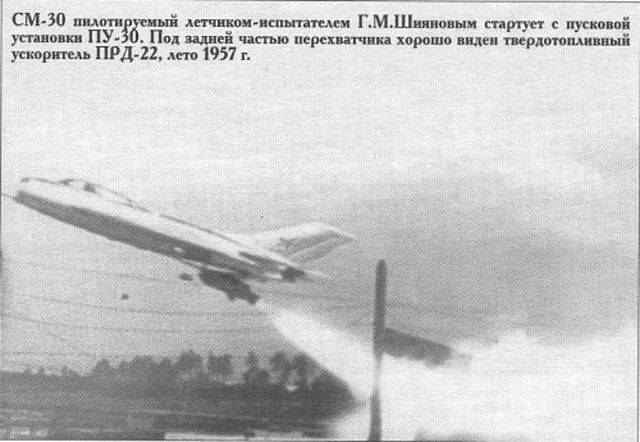
The first manned launch of the SM-30 held 13 April 1957 of the year. Testing the whole system resulted mainly from the positive evaluations. During carrying out of the state tests was not a single case of a system failure. In the act of state tests, in particular, It was observed: SM-30 taking off is simple, it is available to pilots, already mastered flying on MiG-19. Despite this further test flights, it never went.
One of the problems, which prevented the adoption of such aircraft into service, it was, that despite the start require an airfield for landing fighter was still needed airfield, and deliver bulky launchers in remote areas of the country was quite problematic. Transportation and hindered the large dimensions of the system, which complicated the transportation by rail. In this case, the CM-30 was created primarily for the needs of the country's defense and the protection of military facilities on the northern borders of the USSR, including Novaya Zemlya, but by that time adopted the first anti-aircraft missiles began to arrive. Antiaircraft missiles do not need airfields, and even sit fired missile will not be. That is why the military quickly lost interest in the SM-30 and catapult to launch fighter jets.
It is one thing to raise in the sky 8-ton fighter and quite another 200-ton bomber. The draft strategic supersonic bomber M-50, over which in myasishchev we started to work in 1950, It was quite ambitious for its time. Aircraft designed focusing the flying velocities in the range of from 270 kmh (landing speed) to 2000 km / h at altitudes of up to 16 000 m. Maximum range with considering in-flight refueling was to be 15 000 kilometers. The maximum launch weight at start using accelerators reached 253 tonnes, of which fuel had 170 tonnes.
Even when set off distance of three kilometers for bomber M-50 was mandatory use of rocket boosters. The calculations showed, without using them for a maximum take-off aircraft bomb load required concreted strip six kilometers. In comparison to the space shuttle "Buran" at Baikonur was built strip length 3,5 km. However, even in the Soviet Union three-kilometer runway was extremely small. That is why myasishchev simultaneously with the design of the supersonic strategic bomber started the elaboration of projects, that would facilitate the rise of a new aircraft, including the start point of the system.
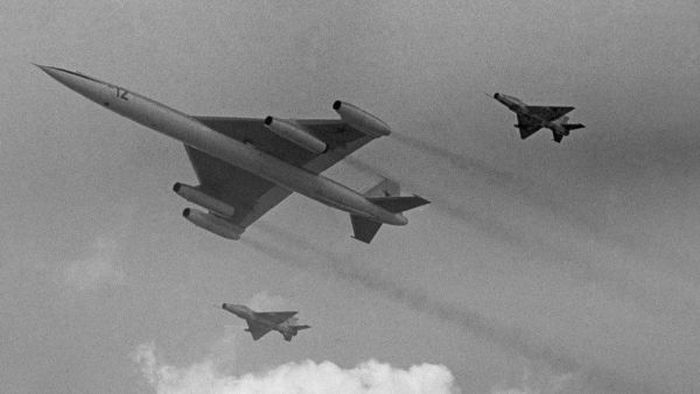 Supersonic bomber M-50 (the only prototype) accompanied by a MIG-21 fighter air parade Tushino
Supersonic bomber M-50 (the only prototype) accompanied by a MIG-21 fighter air parade Tushino
Taking into account the size and dimensions of the projected bomber, launcher with rail, in the case of MIG-19, I was not even considered, I needed a different scheme. As a result, such an option has been proposed start point, wherein the aircraft taking off and rising in the sky via liquid rocket engines, like a real rocket. The starting position in this case consisted of a pendulum design, that is withdrawn from the bomber lands at the beginning of the movement, lifts, required for the installation of the aircraft on the pendulum, as well as pits and reflective devices, which were necessary due to the rocket engine torches.
According to the calculations of the pendulum two main support we had to take over 98 percent load, the rest of the load fell on the tail support. There were also located and rocket boosters: the main two were placed under the wings of the aircraft, another was placed in the rear part of its fuselage. Two underwing rocket accelerator 8 thrust nozzle 136 tons each, They were to be installed at an angle 55 degrees. They created a vertical force, which exceeded the takeoff weight of the strategic bomber, and the horizontal component of the thrust was to help disperse the turbojet aircraft. Located in the wake of the third rocket booster had to remove a vertical yaw. At the same time cross-yaw were adjusted gas ailerons, that have been installed in the main engine jets.
Spot start strategic bomber M-50 was performed in the following manner. First launched major airplane turbojet, then the car stabilized autopilot. Takeoff boosters had such large sizes, that the whole process bomber takeoff was fully automated, while the pilot because of congestion at this time was in a state close to fainting, so it is unlikely to somehow could help in the management of the machine. After the engine starts the main motor and aft rocket located under the wings rocket boosters, starred stops and M-50 up a pendulum to a height of about 20 m, where there is a disconnection process. After reaching the rated speed 450 km / h bomber crossed to normal take-off mode, and spent rocket boosters disconnected and landed using a parachute.
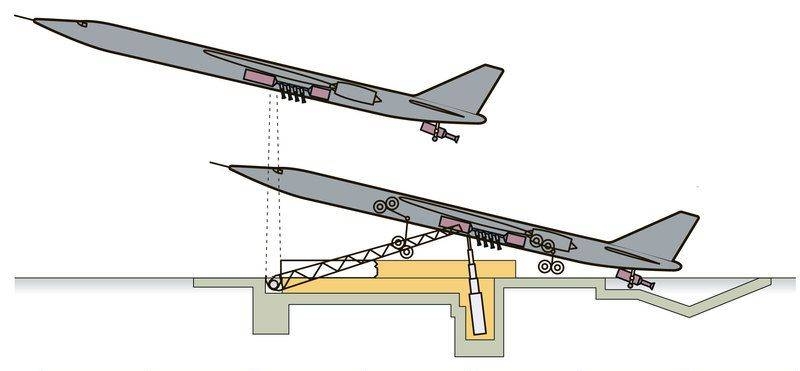 Start point to M-50, render: www.popmech.ru
Start point to M-50, render: www.popmech.ru
In such a system startup had its obvious advantages, which include the ability to start from the parking place of the aircraft; any dispersion of the starting point; a small amount of construction work at a small concrete consumption; Chances are good camouflage bomber; the possibility of simultaneous take-off a large number of bombers. But at the same time there were also disadvantages: the need of gas controls and Stabilization.
Howbeit, see live like start bomber could not be anyone. Project start point of M-50, as well as the placement options on rocket boosters special carts, It has not been implemented in the metal, it ended at the design stage. Unique starting system were not in demand after the successful testing of a ballistic missile R-7 Sergei Korolev, which had a range of flight 12 thousand kilometers and was invulnerable to the existing at that time air defense. After successful ICBM test in the USSR simply turned all the work on supersonic strategic bomber.









